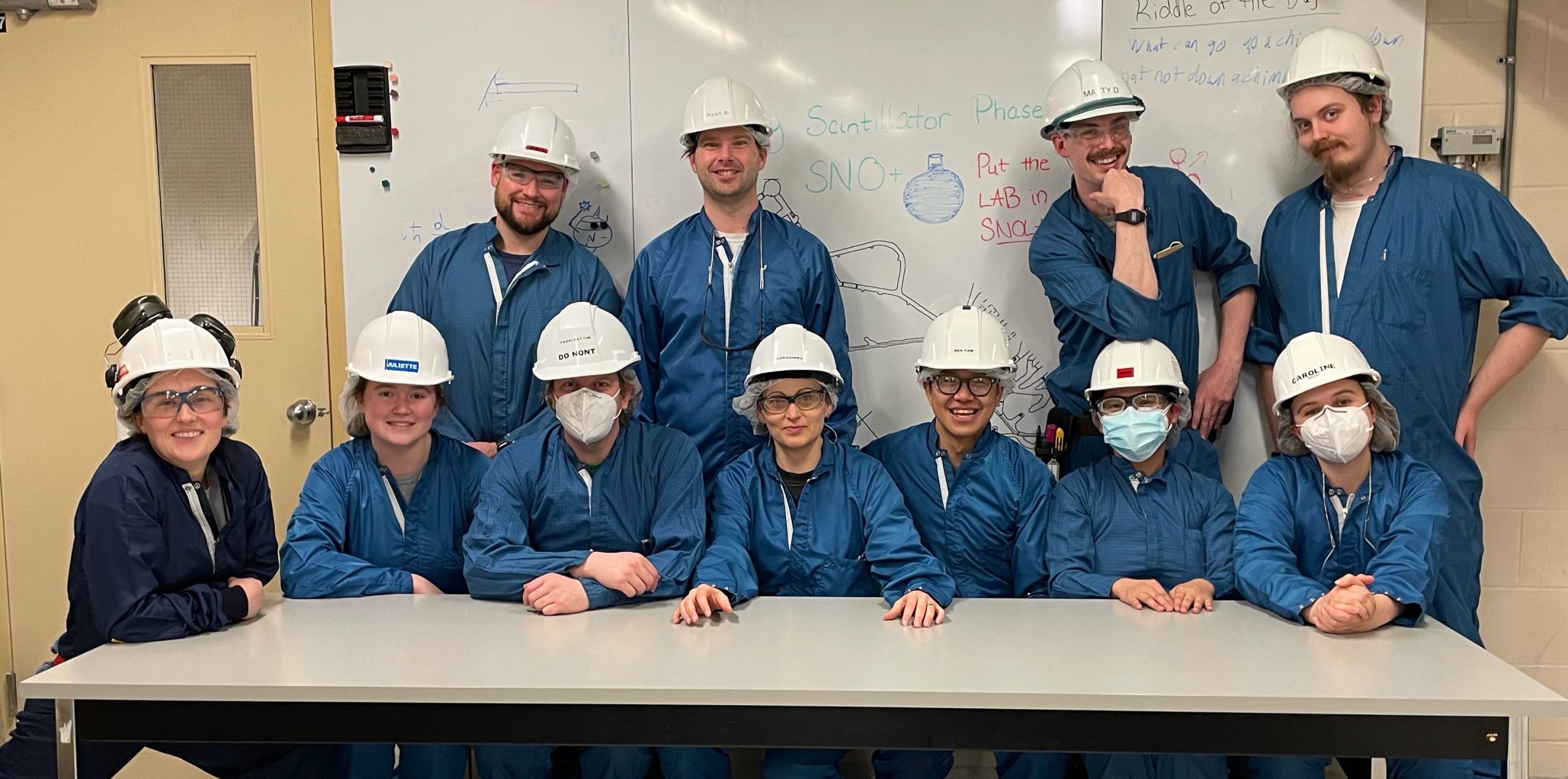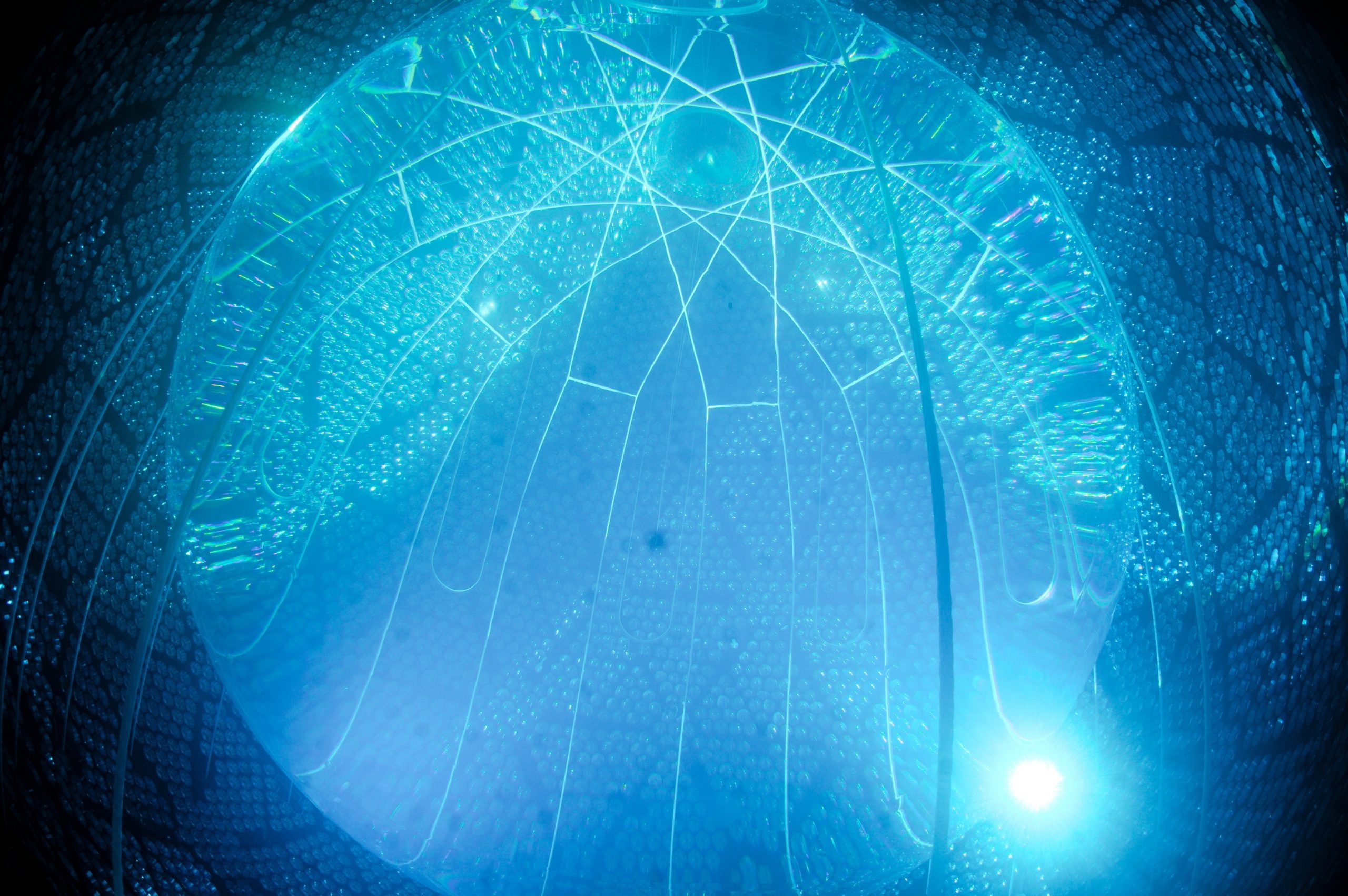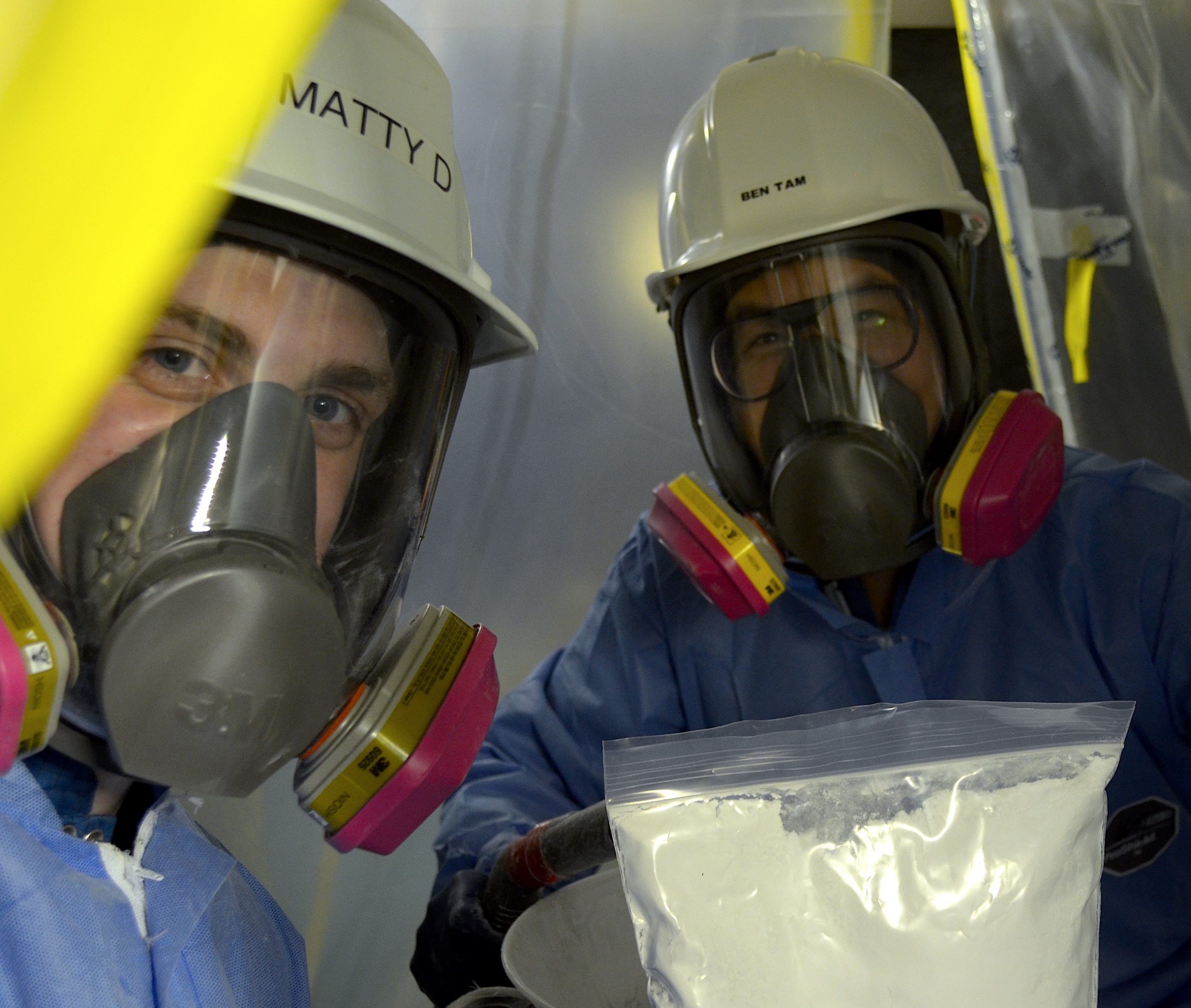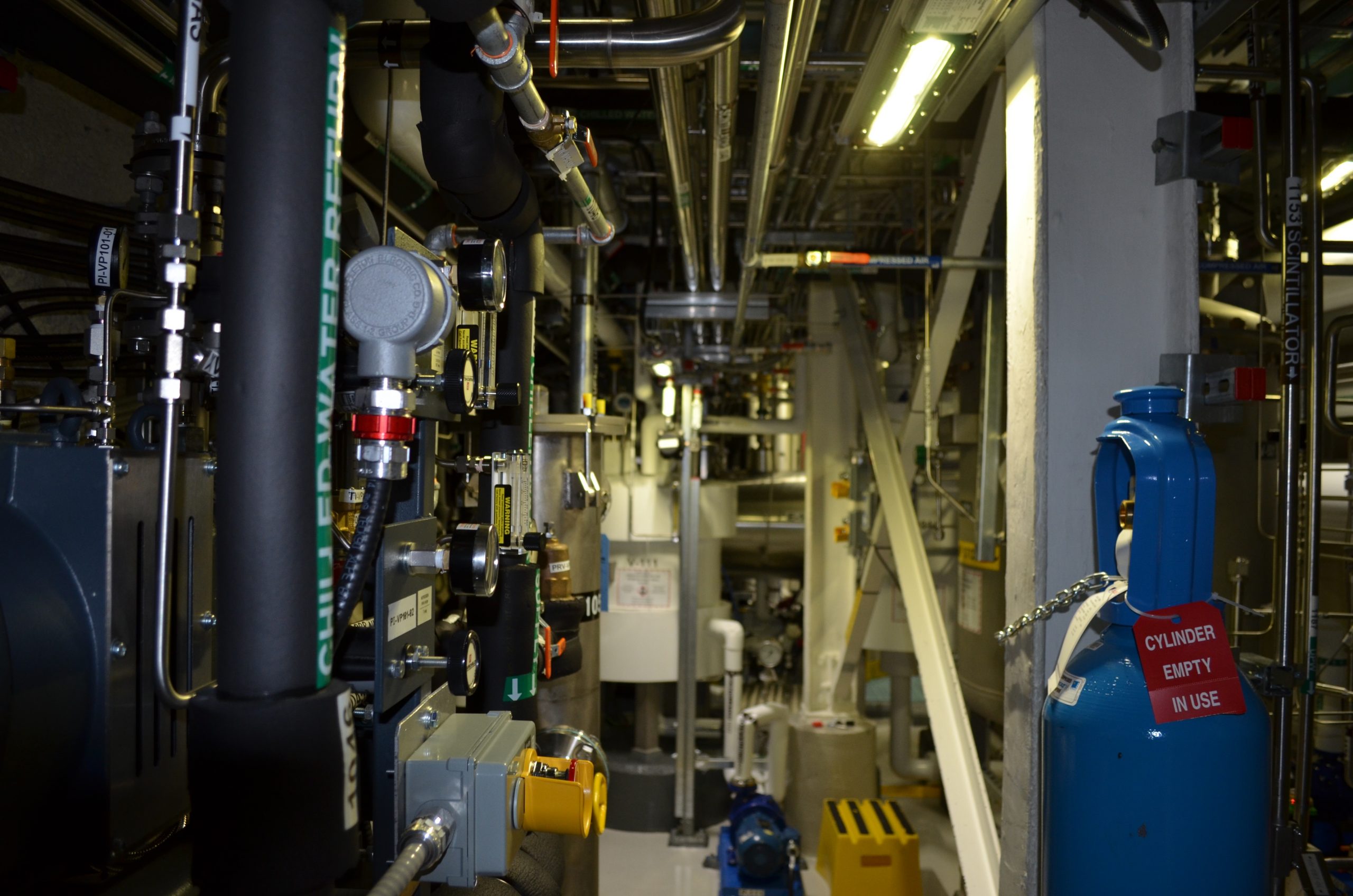SNO+ successfully enters its second operational phase
The SNO+ experiment has completed its second commissioning phase and is now taking data. After an arduous 3.5 year process of building, running, and checking ultra-purifying plants underground at SNOLAB and meticulously filling the SNO+ vessel with high purity liquid scintillator, the SNO+ experiment is ready to detect low-energy neutrinos and shed light on the fundamental nature of neutrinos, supernovae, the Sun, and the Earth’s structure.
3 minute read

Caption: The SNO+ underground team in the SNOLAB lunchroom moments after completing the fill. Standing, left to right: Paul Larochelle (SNOLAB Engineering Office Manager), Ryan Bayes (SNO+ Research Associate), Matt Depatie (SNO+ Detector Technologist), Dalton Jones (SNOLAB Senior Operator). Sitting, left to right: Jasmine Gauthier (SNOLAB Process Engineer), Juliette Deloye (SNO+ Research Assistant), Steve Maguire (SNOLAB Staff Scientist), Aleksandra Bialek (SNOLAB Research Scientist), Benjamin Tam (SNO+ Lead Scintillator QA & PPO Scientist), Yi-Hsuan “Cindy” Lin (SNO+ Postdoctoral Fellow), Caroline Deluce (SNO+ Research Assistant) (Credit: SNO+ Collaboration)

Caption: The SNO+ Detector following the scintillator fill, lit up with 2 spotlights. The inner vessel (12m in diameter) is filled with 780 tonnes of ultra-purified Liquid Scintillator (LAB + 2.2g/L PPO), while the outside of the vessel is surrounded by 7,000 tonnes of purified water. With filling operations now completed, the experiment is now in a data taking phase, and the 10,000 sensitive light detectors in the outer vessel will study interactions of neutrinos from nuclear reactors, neutrinos from heat-producing elements from deep in the Earth, from the Sun, and from distant supernovae. (Credit: SNO+ Collaboration)
The SNO+ collaboration has been working on filling the original SNO vessel with ultra-pure liquid scintillator for the past 3.5 years. Previously, the vessel was filled with water and successfully completed its last operational phase in 2019. During its second commissioning phase, SNO+ was filled with an ultra-pure liquid scintillator based on the chemical called linear alkylbenzene, nicknamed “LAB”, from the top while the water was drained from the bottom. Requiring a 1 part in quadrillion (1015) purity, the LAB was processed repeatedly through a refining plant to remove potential contaminants such as dissolved water, gasses, and heavy contaminants.
Following the successful filling of 780 tons of ultra-pure LAB approximately one year ago, the SNO+ team has been adding the primary fluor 2,5-diphenyloxazole (PPO). The two tonnes of PPO powder was successfully integrated into the LAB on April 11, 2022. Once the liquid scintillator was sufficiently well-mixed and high purity was verified, the refining plant process was completed and the operational phase began on April 29, 2022.

Caption: Matthew Depatie (Left) and Benjamin Tam (Right) inserting the final amount of PPO into the system. (Credit: SNO+ Collaboration)
The physics goals for SNO+ in this phase span geophysics, astrophysics, and particle physics. They all rely on detecting low-energy neutrino events in the MeV energy range, which SNO+ is designed and poised to detect.

Caption: Benjamin Tam (Left) and Yi-Hsuan “Cindy” Lin (Right) performing a suite of chemical analytical tests on the liquid scintillator to ensure high standards of purity. These tests were performed by SNO+ scientists once per hour, 24 hours per day, during the duration of the Scintillator Fill. (Credit: SNO+ Collaboration)

Caption: Part of the purpose-built underground purification plant used to process (and reprocess) all components of the liquid scintillator to exceptional levels of purity. (Credit: SNO+ Collaboration)
In this current operational phase, the SNO+ collaboration anticipates detecting geoneutrinos to learn more about the Earth’s elemental abundances and energetics, supernova neutrinos to pinpoint what happens during the early stages of a supernova, and solar neutrinos at energies lower than those studied previously by the Sudbury Neutrino Observatory.
One of the highly anticipated physics results for this data phase is the detection and better understanding of anti-neutrinos from nuclear reactors. SNOLAB is uniquely positioned from surrounding nuclear reactors, leading to SNO+ being optimally located to measure the second oscillation peak and significantly contribute to the fundamental understanding of neutrinos.
With the second operational phase underway and SNO+ anticipated to be one of the most sensitive neutrino detectors in the world, the SNO+ collaboration is simultaneously preparing for their ultimate goal; detecting neutrinoless double beta decay. After this current operational phase, SNO+ will go into one final commissioning phase to dope the ultra-pure liquid scintillator with Tellurium-130 before entering its final culminating operating phase.
Detecting neutrinoless double beta decay (if it exists at all) would confirm neutrinos do not act like other particles, and has far reaching consequences for our understanding of particle physics and the origin of the universe. With SNO+ on track to be one of the most sensitive, ultra-pure detectors ever operated, we look forward to the new physics it uncovers!
